The 13 Most Iconic Matisse Paintings
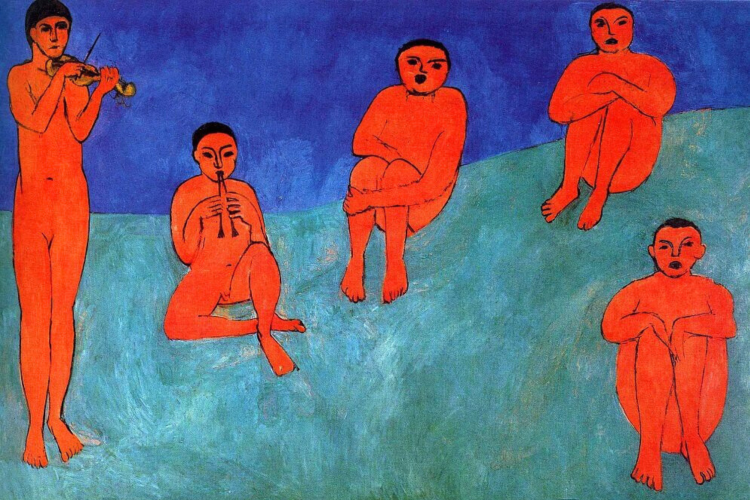
Chances are you have seen Matisse paintings on a trip to a local museum, or even encountered famous Matisse prints hanging on the walls of hotels, offices and more. But what is Henri Matisse best known for? And what was Matisse's most famous piece?
Henri Matisse was a French painter who helped bring about the transition to modern art. According to the National Gallery of Art, Matisse’s long career and body of work “illuminate a man consumed by color, fascinated by pattern, and enamored with the act of creation in wide-ranging materials and forms.”
Not only was Matisse one of the most famous painters, but he also created sculptures, collages and even stained glass windows.
Artists of all skill levels can draw inspiration from Henri Matisse line drawings and Henri Matisse cut-outs. Whether you are looking to increase your knowledge of the art world or find some interesting canvas painting ideas or abstract painting ideas for your next DIY project, these famous Matisse paintings can inspire you to take risks with color and shapes in all your future artwork.
Jump to Section
Who Was Henri Matisse?
What are 5 facts about Henri Matisse? We’ve got far more than five facts about this inspirational artist. Before we get to his most iconic paintings, here is a brief summary of the painter’s life and accomplishments.
Henri Matisse was an influential French artist who helped lay the foundations of modern art. His work extended beyond painting to drawing, sculpting and making paper cutouts and collages. He even worked as a book illustrator and designed stained glass windows.
Born on December 31, 1869, Matisse originally studied to be a lawyer before embracing his artistic calling at the age of 20. In 1891, he left home and journeyed to Paris, where he would spend the next seven years studying art.
During his years of study, Matisse focused mainly on the works of the Impressionists and Post-Impressionists. Many of his earliest paintings show his mastery of the painting techniques that artists like Paul Cezanne and Vincent Van Gogh had invented.
When looking at Matisse paintings in chronological order, you can see the development of his style over time.
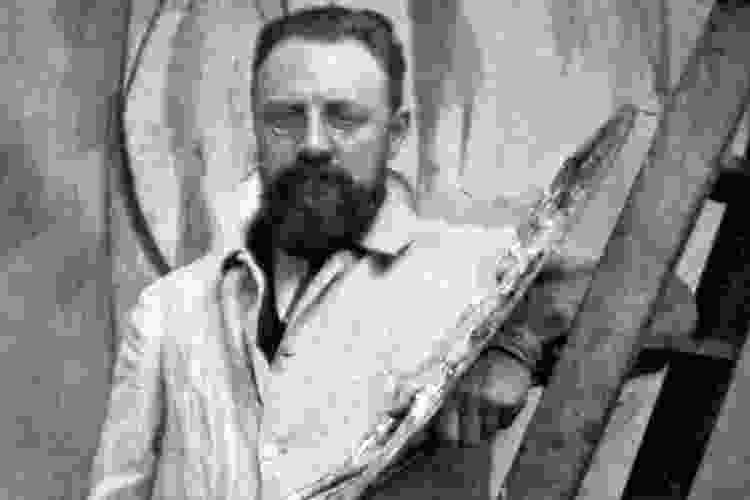
In 1905 he moved away from his study of the Impressionists and Post-Impressionists, but his deep understanding of their use of color and light helped him to pioneer a new movement in French art called Fauvism.
The Fauves (French for “beasts”) were a group who experimented with flat planes of saturated color and art that was inspired by their own lives and experiences.
Fauvist paintings used color without extensive shading or modulating, and their canvases were filled with bright hues that could sometimes be unsettling or disorienting, which is the main reason why these groundbreaking artists were called “wild beasts.”
The Fauvist movement was short lived (it only lasted from 1900 to about 1908), but it set the stage for a huge shift in modern art. During this period, Matisse met fellow artist Pablo Picasso, and they began a friendship.
Did Matisse and Picasso get along? Their friendship was a true example of artistic co-inspiration, with each painter being challenged, encouraged and inspired by the other. While there certainly was some rivalry between these two great modern artists, their relationship was one of underlying respect.
They differed in their views on the direction that modern art should take, but many of their works contain elements inspired by the other.
In 1908, Matisse opened a school for artists, where he taught students in the years leading up to WWI. In taking on the task of instructing and inspiring students, we can learn that art doesn’t have to be intimidating.
In fact, there are plenty of resources available that teach painting for beginners or even specific genres of painting like oil painting for beginners. Matisse long believed that art should be a comfort to people, and finding your passion and inspiration in painting can certainly be one way of decreasing stress and anxiety.
During the war, his art was affected and became noticeably less colorful. This was a reflection on global affairs and his own levels of inspiration. When the war ended, however, he entered into what we now call his Nice period, which showed the bright light and color of the south of France.
Around 1930, Matisse traveled to other countries for inspiration and began branching out into other media forms, which is why we now have Henri Matisse line drawings, sculptures and more.
Late in his life, Matisse became ill and was confined to a wheelchair. Because of his limited mobility, he switched from painting to creating cutout and collage artwork.These types of art were easier to manage, and didn’t require him to manage a palette or figure out how to clean paint brushes in his condition.
Far from being a downturn in his artistic talent and production, Henri Matisse cut-outs and Matisse collages are often considered to be works that helped transform modern art. He died in 1954 of a heart attack, after a long and illustrious artistic career.
Now that you know a little bit about this inspirational artist’s life, let’s dive into 13 of the most iconic Matisse paintings.
The Most Iconic Matisse Paintings
1. Luxe, Calme, et Volupte (1904)
One of Matisse’s earliest paintings, ‘Luxe, Calme, et Volupte’ demonstrates his thoughtful study of Impressionism and Pointillism.
You can see the influences of Paul Signac and Georges Seurat in the way Matisse creates the image through a series of dots and dashes. This painting is often considered the beginning of Fauvism.
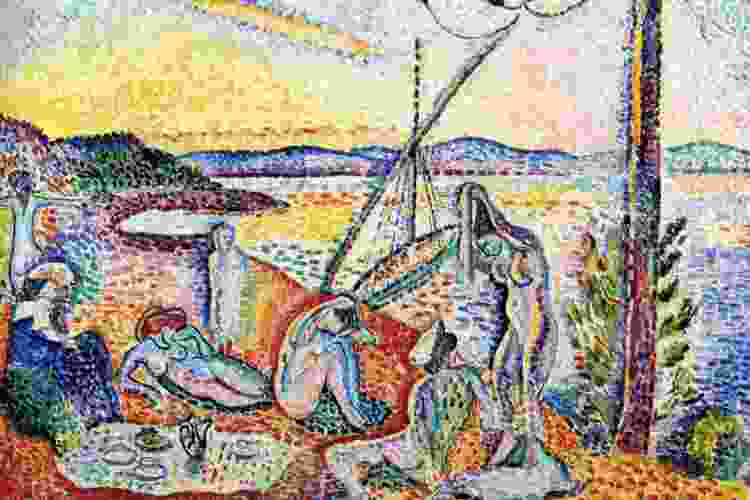
2. The Woman With a Hat (1905)
In 1905, Matisse painted a portrait of his wife, but instead of using traditional, lifelike colors, he used brilliant blues, greens and purples paired with vibrant oranges to create a new take on portraiture.
Many artists and critics of the day were shocked by his use of color, but this was only the first stepping stone in his long relationship with color theory and use.
3. Olive Trees at Collioure (1906)
This Matisse painting, which depicts a grove of olive trees, is one of the most important of Matisse’s Fauve period.
He uses colors that seem unrealistic, but create a beautiful image of the light, airy environment of the French Mediterranean.
4. Blue Nude (Souvenir de Biskra) (1907)
Throughout his career, Matisse often returned to painting and drawing the human form. One of his critiques of Impressionism was that it neglected the shapes of people. He painted his first blue nude after a sculpture he was making broke.
His painting here is not a typical portrait of a nude woman, with soft lines and glowing light. Instead, he makes the image sharper and full of interesting color contrasts. The way he paints the woman’s face and body with such deep strokes of color could inspire lots of things, from your own DIY projects to creative body paint ideas.
5. The Dance (1910)
Between 1909 and 1910, Matisse worked through several preparatory drawings and paintings of ‘The Dance’, which is a huge canvas depicting five figures dancing in a ring on a background of bright blue and green.
This painting shows Mattise’s continuing style evolution, and each successive draft shows how he worked towards perfecting the final image he wanted to create.
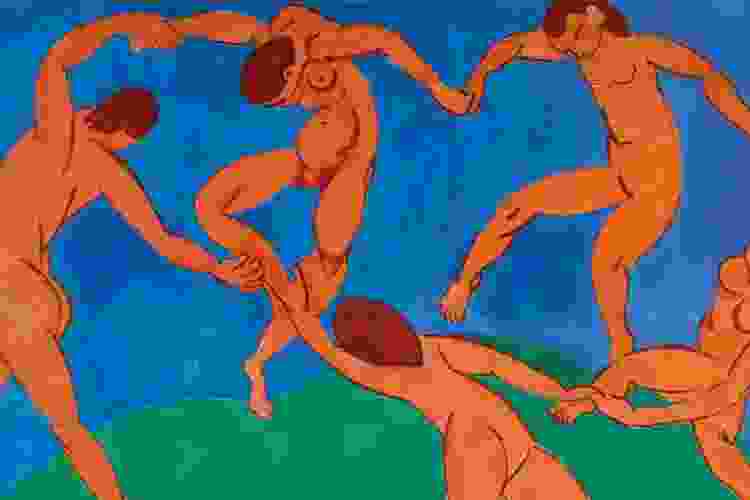
6. Music (1911)
‘Music’ by Matisse was painted in 1911 and contains many of the same color and style elements as ‘The Dance’.
It features five bright orange men, some with instruments and some without. They are also positioned on a green and blue background, but in this image they are not holding hands and standing in a circle, they are all positioned separately across the space.
Many people have drawn connections between ‘Music’ by Matisse, and ‘The Dance’ due to their connected themes and styles.
7. The Red Studio (1911)
‘The Red Studio’, an oil painting completed by Matisse in 1911, is often considered to be one of the turning points of modern art. This Matisse painting shows his studio, but aims to remove the illusion of artwork that viewers expect.
Instead of using paints to draw the items in his studio, he uses the color red over everything and allows the canvas to show through in the outlines of the items. This is a reversal of the way artists had used perspective and illusion for centuries, and is what makes Matisse paintings such masterpieces.
8. Goldfish (1912)
Painted in 1912, ‘Goldfish’ is one of Matisse’s best-known paintings. Even though he painted this image after the Fauvism movement had ended, you can still see his roots in that movement demonstrated in this painting.
The background is full of leafy green plants, while the three bright orange goldfish in the bowl draw your eye. ‘Goldfish’ is a great example of how he used contrasting colors to draw your eye to specific parts of the painting.
9. Bathers by a River (1917)
This 1917 Matisse painting is a stunning work of modern art, and Matisse himself believed it to be one of the most pivotal works he ever created.
In fact, he spent seven years working through different versions of the painting until he finally was pleased with the way he represented the human figure.
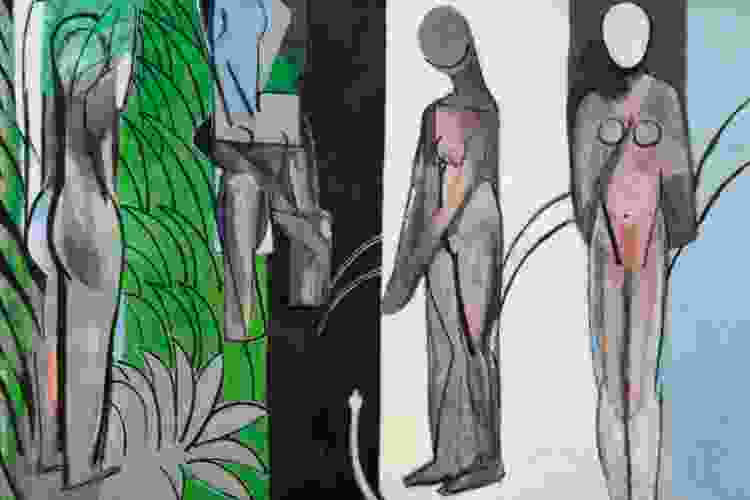
10. The Dance II (1932)
‘The Dance II’ returns to the themes of ‘The Dance’ and ‘Music’, but it once again shows his development as an artist.
Instead of being painted on one large canvas, this piece is a triptych of three arched canvases. It incorporates Matisse’s use of color as well as cutouts.
11. Jazz (1947)
In 1947, confined to a wheelchair, Matisse began creating a unique art book that featured his collages and cutouts combined with his thoughts.
The cover of the book, which shows a black figure on a field of royal blue surrounded by yellow stars, is one of the most popular Matisse prints.
12. Bees (1948)
As Matisse began to experiment more with paper cut outs, he also created patterns for stained glass windows.
One of these that shows his first venture into more abstract art is called ‘Bees’. Unlike other Matisse paintings, this Matisse collage shows a more geometrical pattern, with the bees emerging as you stare at the large piece.
13. Blue Nude II (1952)
Towards the end of his career, working in cut-outs, Matisse revisited some of the same themes and ideas he painted as a young artist. It is interesting to look at his Blue Nude painting from 1907 compared with his blue nude cut-outs from 1952.
You can see that he is still the same artist, but his personal style and his beliefs about modern art truly shaped the way he created over his long career.
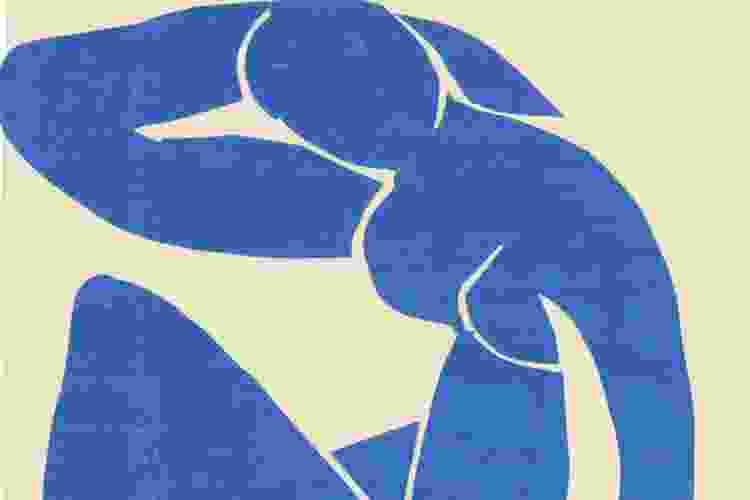
We hope this guide to the 13 most iconic Matisse paintings has helped you answer the question “What’s so special about Matisse?” His artwork ranged in style from Impressionism to abstract and modern art, and artists and enthusiasts alike have been inspired by his use of shapes and colors for decades.
For even more fun painting ideas, check out other experiences happening on Classpop!


